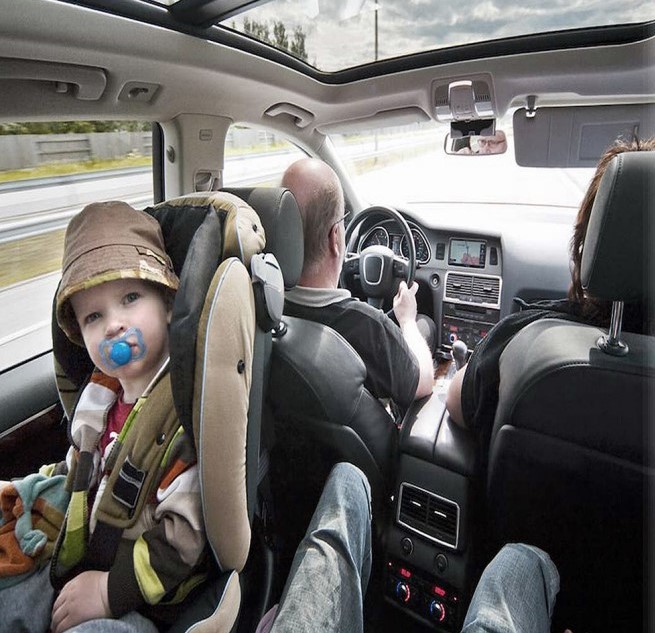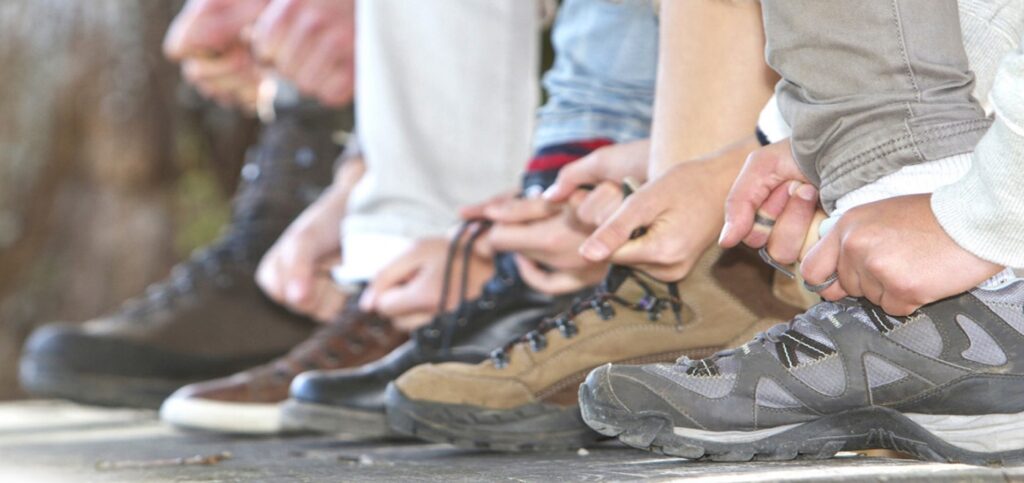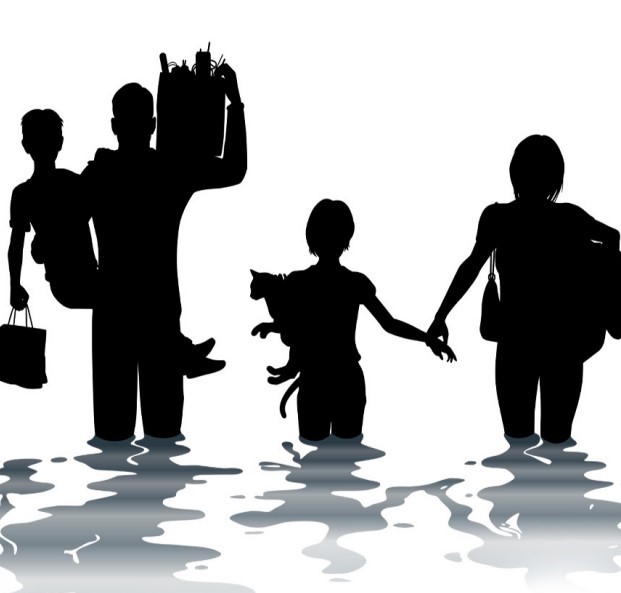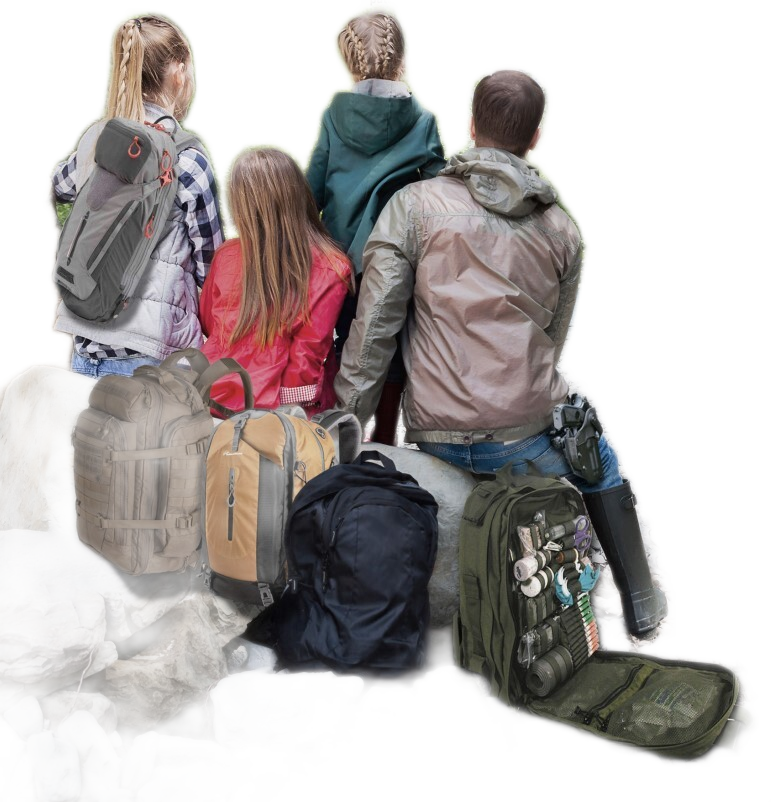It’s happened. Disaster struck, and now you and your prepper spouse need to get your family out of here. The roads are clear, for now, but your car will only take you so far—maybe not as far as you think. Beyond that, you’ll be on foot. Your spouse has the logistics taken care of, bug-out bags packed and ready to go, route planned, skills practiced to keep you all sheltered and protected along the way. All you need to do is keep the kids—and yourself—going.
Maybe you’ve been involved with your family’s prepping from the start; perhaps you’ve only smiled and nodded at your spouse’s strange hobby. Either way, you’ve never done anything like this evacuation: so sudden, so dangerous, so real. How can you hold things together for your family on your flight to safety?
First, Stay Calm
YOU CAN DO THIS. If your family has an emergency plan for a situation like this, you’re already ahead of the game. If you’ve practiced it, or pieces of it (packing the car, taking test hikes with the kids, trying out skills like fire-making and camp cooking), all the better. And either way, there’s no use panicking. You’ll get through this trial like you have the rest of your life as a parent, one moment at a time, solving each problem as you come to it.
It’s also vital for the kids that you stay calm and focused. Your kids will mirror your emotional state: if you seem worried, they’ll worry too. Tell them what you know about what’s happening—where you’re going, how you’ll get there when you can return—and what you’ll need them to do along the way. Make it clear that this isn’t a game, but also that you have a plan to follow and that you and your spouse will be with them the whole way through.

In the Car
The best thing you and the kids can do while your spouse drives is rest. You’ll need all the strength you can get when it comes time to walk. Particularly if you have very young children, it’s easiest to travel at night while they’re asleep. But if it’s broad daylight, or if you need to keep going around the clock, you’ll have to keep the kids occupied like you would on any other road trip. If you can, bring a few of their favorite movies, video games, or audiobooks to play in the car. They won’t take up much space, and you can leave them behind or barter them as needed. Plain old notebooks and pencils can also provide a lot of entertainment, especially if the kids are old enough for games like Hangman or Pictionary. Keep snacks on hand for when they get hungry, and make sure everyone stays hydrated—it’s easy to forget to drink when you’re just sitting in a car, but dehydration will bring on lethargy, bad moods, and headaches, none of which you’ll want to deal with now.
To keep a good pace, you’ll need to make every rest stop quick and effective. Have the kids ready to move by the time you stop the car. As your spouse fills the tank or buys food, you can take them to the restroom or give them a moment to run around and stretch their legs. Before you get going again, make sure no one’s left anything behind—but just in case, bring extras of things like hats, mittens, and water bottles so you won’t have to backtrack to retrieve them.

On Foot
With luck, your car will take you as far as you intend it to. If not—if the vehicle breaks down or the roads are blocked—this phase of your journey might start early. The demands on you and the children will only increase from here, and the hazards will multiply. Be as patient with the kids as the situation allows, and model calmness and perseverance for them as best you can. Before you leave the car, take a moment to check your packs. Most physicians recommend that children carry no more than 15 percent of their body weight when backpacking, including both the pack and its contents. This isn’t a leisure hike—it’s more important that your kids survive the experience than enjoy it—but even so, staying as close as you can to this guideline will lower their risk of injury.
If you have a small child with you who might tire quickly and slow the group down, you may also want to keep the adults’ packs light enough that one can double up while the other carries the child. Everyone in the group should carry, at minimum, their own water bottle, rain gear, light source, and whistle in case they get lost, and the rest of the supplies should be divided up so that if one pack goes missing, it doesn’t take all of your food or all your spare clothes with it. Make sure the kids’ packs are adjusted to fit properly (with the hip belt, which should hold most of the pack’s weight on their hips and the shoulder straps at the same height as their shoulders).
 As you walk, keep one adult in front of the party to lead the way and the other in back to make sure no one lags behind. To the extent possible, let the smallest child set the pace—you want them to be able to keep moving under their own power. Keep your rest breaks quick and frequent. Set down your packs for a moment, drink some water, have a snack, and then get going again. Refueling your bodies is even more critical now than in the car. To keep up your energy, make sure everyone drinks before they’re thirsty and eats before they’re famished.
As you walk, keep one adult in front of the party to lead the way and the other in back to make sure no one lags behind. To the extent possible, let the smallest child set the pace—you want them to be able to keep moving under their own power. Keep your rest breaks quick and frequent. Set down your packs for a moment, drink some water, have a snack, and then get going again. Refueling your bodies is even more critical now than in the car. To keep up your energy, make sure everyone drinks before they’re thirsty and eats before they’re famished.
If the situation allows, keep up a conversation as you walk. Tell stories, sing songs, or even review the kids’ times tables or geography facts—anything to keep their minds occupied and maintain some sense of normalcy. You could also show the kids some edible plants, if you know any that are in season, and forage a bit of fresh food as you go. (Some easy plants to identify and eat are dandelions, wild strawberries, blueberries, blackberries, persimmons, and hickory nuts.)
Stay alert as you travel for any dangerous wild animals like bears, wolves, or mountain lions. Although these animals usually flee from adult humans, a child that wanders off alone might register as prey to them (yet another reason to always keep your children within sight). If you do encounter a predator, walk calmly and slowly to stand beside your child and pick up the child if you can. Shout and clap at the animal to scare it off. If it approaches, stay between it and the child. And in the rare case that it attacks, channel your inner mama (or papa) bear and fight back with whatever you can reach, whether that’s a gun, a stick, your pack, or just your hands. Do anything you can to show the animal that you and your kid aren’t worth the trouble.
When you stop for the night, check each child for any blisters, scrapes, rashes, or tick bites that need treating, and make sure their shoes and pack are still in good condition. Keep them engaged as you set up camp by assigning them age-appropriate chores. Maybe one can help you pitch the tent while another goes with your spouse to gather firewood or bring up water. Make dinner as appealing as possible so that everyone eats enough to keep them warm through the night, bring sauces, spices, and sweets to flavor your staples. If your kids have a bedtime routine, stick as close to it as possible. And even if they’ve outgrown their old routines, they might still appreciate a story or a cup of hot chocolate at a scary time like this. Make sure they don’t bring food with them into the tent—it can attract animals—and keep a headlamp on hand in case they need anything in the night.

Final Thought
Though fleeing for your lives can seem terrifying, it’s unlikely to be a constant adrenaline rush like what you see in the movies. There will be lulls when you can rest—make the most of them—and long periods of simply putting one foot in front of the other down a seemingly endless trail. Bugging out is a test of endurance and strategy, much like parenting itself in this turbulent day and age. You’ve done that for so long already; you can do this too. With luck and preparation, you and your family will all survive this threat— and you just might come out of the experience closer to each other than ever before.
This article was written by Laura Handley and originally published in Survival Dispatch Insider Volume 4 Issue 3.
